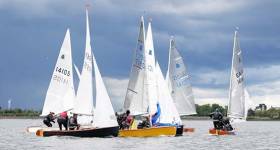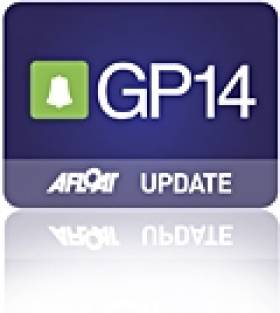Displaying items by tag: Swords Sailing & Boating Club
Swords Sailing & Boating Club Vice Commodore Siobhan Broaders has presented a cheque for €500 to Howth RNLI lifeboat service on board its Trent Class lifeboat in County Dublin.
The North Dublin club raised funds through a New Year's Day sail and the annual club quiz held in March.
SSBC's Robert McKay, Stephen Broaders, and Siobhan Broaders attended the presentation with Howth RNLI Ops Manager Colm Newport.
Mitch Booth Booked For High Performance Seminar At Swords This May
#MitchBooth - Olympic catamaran sailor Mitch Booth has been booked to give a two-day high performance tutorial at Swords Sailing & Boating Club this May, organised by the Irish Multihull Association in tandem with the Avon Ri sailing school in Blessington.
An Olympic medalist in the Tornado two-handed multihull for Australia at the Barcelona and Atlanta Games, Booth later sailed internationally for the Netherlands, among his accolades winning bronze at the 2003 World Championships and gold at the 2003 Europeans.
Since then his sailing career has taken him further offshore, such as ocean racing in maxi cats, as well as in keelboats and the challenges of the America’s Cup.
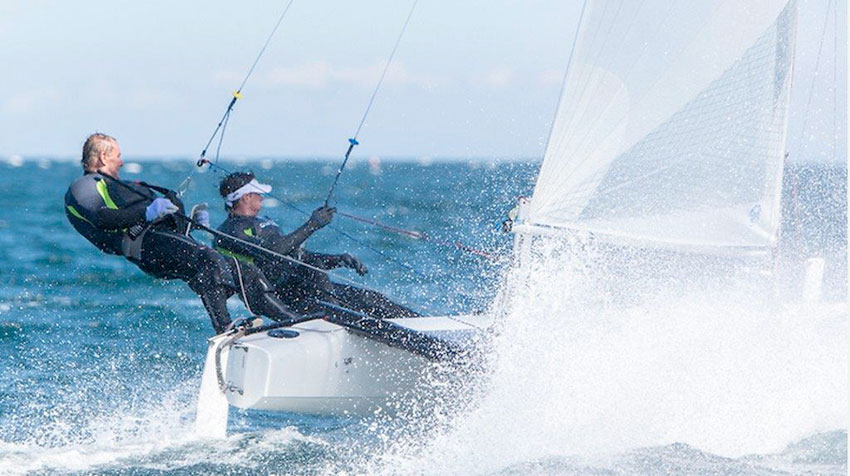
Off the water, Booth was involved in the creation of the Olympic Tornado class rig, and he has more than 100 different multihull builds to his name — including A Class cats he helped design.
Lately, he is attempting to develop the the largest cruising catamaran ever built under the brand BlackCat Superyachts, as previously noted on Afloat.ie.
For details on how to attend the two-day tutorial, contact Swords Sailing & Boating Club HERE.
The Riocard O’Tiarnaigh GP14 Challenge 2017 was hosted by Swords Sailing Club on Saturday 29th & Sunday 30th April. 17 boats from as far north as Moville and south as Dungarvan, attended despite the challenging forecast which proved to be accurate.
All boats launched and race one was started on time. Conditions looked fine from shore but once on the race course it was a very different story and most competitors tested the water temperature at least once throughout the day.
Bronze, Silver and Gold fleets each sailed in separate flights with 4 boats in the bronze, 5 in silver and 8 in gold.
Race one was won by Sam Wray & Michael Broaders, Sligo YC, in the bronze fleet from Martin & Vicky Dews, Donahadee SC, Bill & James Johnson, Lough Foyle YC, in the silver and Shane McCarthy & Damian Bracken did a horizon job and showed the gold fleet a clean pair of heels. There was a lot of place changing with the McGuiness brothers eventually taking 2nd place and the McCaldins in 3rd.
Race two was quickly started although some competitors chose to head for the shore. No finishers in the bronze fleet, the Johnsons again dominated the silver fleet. In the gold fleet 3 of the top 4 boats capsized within 5 boat lengths of the weather mark, allowing Hugh Gill & Conor Twohig, Sutton DC, to take a clear race win with Keith Louden & Alan Thompson also staying upright to take 2nd. The McCaldins recovered from their swim to take 3rd.
After lunch ashore a depleted fleet reluctantly relaunched to find the conditions even more challenging on the race course. 3 short races were sailed.
Two 1sts in the bronze fleet saw Blessington SC’s Matthew Street & Lee McMullan take a single point victory from Sam Wray & Michael Broaders.
One 1st and two 2nds saw the Johnsons take the silver fleet from Stephen & Peter Boyle, Sutton DC with Dungarvan SCs father and daughter team, Simon & Ella Crowe taking 3rd.
McCarthy & Bracken dominated the gold fleet with a further three 1sts showing great speed and boat handling in the gusty conditions. The McGuinness’s secured 2nd place with three 2nds and the McCaldins 3rd with two 3rds and a 4th.
Sunday dawned as forecast with winds mid 30mph, the race officer wisely decided not to hold the finals.
Next event on the circuit is Greystones SC 27th & 28th May.
The GP14 Riocard O'Tiarnaigh Challenge was again this year held at Swords Sailing and Boating Club on Saturday 21st and Sunday 22nd of May. It was sailed as a combined event with the Purcell Trophy this year due to the 2016 World championships being held in Barbados at Easter. A warm welcome was given by the club to all competitors and their friendship and hospitality was extended thought the weekend, with their incredible race management on the water and their fantastic catering and ashore.
The results of the Purcell trophy were rolled over from the Saturday and used partly as qualifying for the Riocard O'Tiarnaigh Challenge final. A total of 7 races would be sailed for qualifying purposes with one discard to be used. After the Purcell event results were counted three shorter races with separate fleet starts were scheduled to be sailed on the Sunday morning.
Qualifying positions for the gold and silver fleets were wide open with a number of boats able to fill the four qualifying positions for each fleet.
In the first two races on the Sunday morning in the gold fleet Keith Louden and Alan Thompson took two race wins and Shane McCarthy & Damian Bracken took two second places. John & Donal McGuinness qualified in third place, this left the last place open and to be contested in the final race by three boats. Niall Henry and Ossian Geraghty took the race win and with other results going their way, they grabbed the final place. However they would later choose not to contest the final and pass on the final slot to Hugh Gill and Simon Revill.
The Silver fleet was just as hotly contested with the final places being decided in the final race of qualifying with Michael Cox and Josh Porter, Simon Jeffery and Alan Henry, Katie Dwyer and Michelle Rowley and Simon Cully and Richard Street all making it through.
The bronze fleet sailors Ian Nish and his crew Des, and Keith and Barbara Leonard who had already qualified, went out on Sunday morning to test out the conditions and get some practice in preparation for the final.
At lunch time the wind died away completely but when PRO Peter Smyth blew his whistle to signal end to lunch the wind duly obliged and within half an hour it had settled in to a steady force 3 in strength. However it was still shifting back and forth in direction, as it had done all weekend in preparation for the final.
The first race saw a great start by Katie Dwyer & Michelle Rowley and when they rounded the windward mark with a sizeable lead they could not be caught by Shane McCarthy & Damian Bracken, a result which would prove significant for the girls by the end of the day. John & Donal McGuinness crossed the line in third place.
Second race saw Shane McCarthy and Damian Bracken take an early lead which they would maintain to the end and with positions changing behind them Keith Louden & Alan Thompson took second and John & Donal McGuinness were third.
In the third and final race points counted double which meant any number of boats could still win the event, Keith Louden & Alan Thompson led at the windward mark and held on to that lead until the final leeward mark when they were passed by Shane Mc Carthy & Damien Bracken. Keith Louden & Alan Thompson finished second and Katie Dwyer & Michelle Rowley in third.
This result gave Shane McCarthy & Damien Bracken the Riocard O'Tiarnaigh Challenge win, Katie Dwyer & Michelle Rowley took second in a break of tie with Keith Louden & Alan Thompson in third place.
Swords Sailing Club Stages GP14 Dinghy Challenge
#gp14 – The GP14's kicked off the season with the Riocard O'Tiarnaigh Challenge sailed at Swords Sailing Club on the weekend of the 18th and 19th of April. A total of 20 boats turned up to compete for the championship which was run in individual fleets Gold, Silver and Bronze over the Saturday and Sunday. The top four in each fleet qualify for the final three race sail-off to determine the overall winner on the Sunday afternoon. Results downloadable below as a word file.
With a steady 13 knot breeze the bronze fleet were first to take to the water and the young Gallagher brothers Gareth and Richard showed early form to lead the first race from start to finish. In the silver fleet it was Simon Cully paired with his old crew Richard Street who took line honours while in the Gold fleet it was the Tim Corcoran and Brendan Brogan, back after a year's sabbatical who showed the early form and took the first race.
As the day progressed it was the young Gallagher brothers from Culmore who dominated the bronze fleet winning all but one of the six races on the Saturday. It was young Peter Boyle crewed by the auld fellow Stephen who won the last race of the day to hold second place overnight in the bronze fleet. Third place overnight was Adrian Lee and Edward Coyne from Youghal. Adrian and Edward sailed a consistent series finishing either second or third in each of the six races.
The silver fleet was hotly contested with Simon and Richard taking three of the six races but two DNS meant they were relegated to third overnight. Colman Grimes and David Lappin took two of the six races and were the overnight leaders in the silver fleet. Bill and James Johnson won one of the six races and finished the day in second place.
Despite Tim and Brendan's early showing it was Niall Henry and Ossin Geraghty who dominated the first day in the Gold fleet taking two of the first six and finishing second in three of the others. Shane MacCarthy and Damian Bracken finished the day in a creditable second place taking one of the six races and finishing second and third in the rest. The Mc Guinness brothers held third place overnight with consistent top four finishes.
On Sunday morning there was still three races to sail in the qualification series and qualification open to almost all the fleet. The Gallagher brothers, who after their strong showing on the Saturday had already qualified for the final didn't need to sail but decided to go out and get a feel for the course in preparation for the final. They sailed the first race and then came ashore to rest while the other battled it out for the remaining qualification spots. Peter and Stephen Boyle, Adrian and Edward from Youghal and Michael Collender with Brian Walker from Mullingar took the other qualification spots for the final. In the silver fleet it was Colman and David, Simon and Richard, Bill and James with Gerry Gilligan and Lucia Nicholson who qualified for the silver fleet. In the gold fleet the qualification places went to Niall and Ossian, Shane and Damian, John and Donal with Tim and Brendan taking the final spot.
The first race in the final saw Simon and Richard a little to eager to start and earned a black flag for their troubles. Niall and Ossian lead at the weather mark and held it all the way to the finish. Shane and Damian were second with Tim and Brendan third. Race two saw a reversal in the top two positions with Shane and Damian taking the first place and Niall and Ossian taking second. With double points for the last race, the overall result would depend on which of the two inform teams could come out on top. In the end it was Shane and Damian who won the race and the championship with Niall and Ossian finishing second overall with the McGuinness brothers taking the last of the podium positions. Colman and David took the top honours in the silver fleet while Adrian and Edward were the overall winners in the bronze fleet.
Strengthen Fingal's Freedom for the Good of Irish Sailing
#fingal – The Government's recent move to create a framework for the direct election of a new all-powerful Mayor for Dublin was expected to be a shoo-in. The new Super-Mayor's authority would incorporate the current four local councils of Dun Laoghaire-Rathdown, South Dublin, Dublin City, and Fingal, each one of which had to vote in favour. But Fingal's councillors voted firmly against it, despite emphatic support of the proposal by the councillors in the other three areas. As a Fingallion by adoption, W M Nixon strongly supports this independent move by a largely rural and coastal region which has a longer shoreline than all the other Dublin areas put together, and is clearly not a naturally integral part of the city.
Fingal is the Ukraine of Leinster, and the glowering monster of Dublin is the Russia within Ireland, intent on the conquest of its smaller freedom-seeking neighbour. Vigorous, all-powerful, intensely urban, and distinctly impressed with itself, Dublin is certain that the further its bounds are spread, the better it will be for all its citizens. And the more citizens it can claim, then the better for Dublin.
But Fingal is different. For sure, it can seem a bit sleepy and rural by comparison with central Dublin, but that's the way we like it. It's a place of odd little ports and much fishing, a region of offshore islands, rocky coasts and many beaches on one side, and the profound heart of the fertile country on the other. A place where – as you move north within it - you might make a living in many ways at once, taking in growing vegetables, raising animals, running a dairy herd, and keeping a lobster boat down at the local quay, while perhaps having a horse or two as well. And if you feel like more shore sport, the golfing options are truly world class.
As for the sailing and all other forms of recreational boating, Fingal is not just a place of remarkable variety – it's a universe. With five islands – six if you count Rockabill – its 88 kilometre coastline is one for sport, relaxation and exploration. Sea angling is well up the agenda, and it's a kayakers' paradise, while Irish speed records in sailboarding and kite-surfing have been established in the natural sand-girt canal which forms for much of the tidal cycle in the outer Baldoyle estuary immediately west of Howth.
Apart from fishing boats – and inshore they're usually only the smaller ones – it has no commercial traffic. And though there are tidal streams, in southern Fingal's main racing area between Ireland's Eye and Lambay, they're not excessively strong, and run in a reasonably clear-defined way, while the flukey winds which so often bedevil Dublin Bay away to the south are much less of a problem in sailing off Fingal, where the winds blow free.
The range of boat and sailing clubs of Fingal matches the variety of its coast. The most southerly is Sutton Dinghy Club, rare among Ireland's yacht clubs in being south-facing. It may be focused on sailing in Dublin Bay, but scratch any SDC sailor, and you'll find a Fingallion. Round the corner of the Baily – not a headland to be trifled with - Howth has two clubs, the yacht club with its own marina, and Cumann na Bhad Binn Eadair (the Howth Sailing & Boat Club) in the northeast corner of the harbour, while Howth Sea Angling Club with its large premises on the West Pier is one of the tops in the country.

The sunny south. Sutton Dinghy Club is Fingal's most southerly sailing club, and is also rare in Ireland through being south facing.
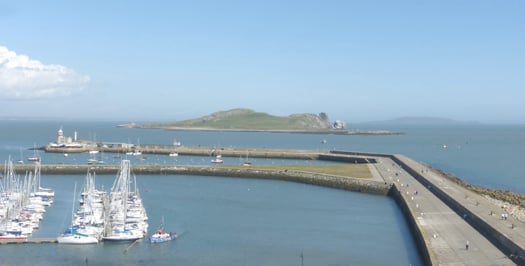
Islands of Fingal seen across the eastern part of Howth marina, with Ireland's Eye in the foreground, and Lambay beyond. Photo: W M Nixon
As for the waters they share, their most immediate neighbour is the steep island of Ireland's Eye with its pleasant southwest-facing beach, the island itself a remarkable wild nesting site, particularly when you remember that it's close beside an intensely urban setting. When a discerning visitor described Ireland's Eye as "an astonishing and perfect miniature St Kilda", he wasn't exaggerating.
Across in Malahide, where we find Fingal's other marina, Malahide YC - which recently celebrated its Golden Jubilee and currently has Graham Smith as its first second-generation Commodore – is in the curious position of having two clubhouses. One is a charming and hospitable place among trees within easy stroll of the marina, while the other is west of the long railway embankment which retains the extensive inner waters of Broadmeadow. This makes the waters into a marvellous recreational amenity and boating and sailing nursery, so not surprisingly it is home to active sailing schools. And it is also the base of Malahide YC "west", a dinghy sailing club on the Broadmeadow shore at Yellow Walls, while further west of it again is yet another club, the more recently formed Swords Sailing & Boating Club.

The map of modern Fingal shows how the southwest corner of the present region seems remote from the largely coastal and rural nature of much of the rest of the county. And it also confirms the surprise (to many) that the Phoenix Park is in Fingal.
North from Malahide, and you're into "Fingal profonde", its deeply rural nature occasionally emphasised by the sea nearby. The long Rogerstown Estuary, the next inlet after Malahide, sometimes found itself providing the northern boundary of The Pale, and as recently as the early 1800s the river at Rogerstown and the tiny port of Rush were a veritable nest of smugglers, privateers and occasionally pirates, with buccaneering captains of myth and legend such as Luke Ryan and James Mathews proving to have been real people who were pillars of society when back home in their secretive little communities after their lengthy business forays to God know where.

Muddy situation. Low water in the Rogerstown Estuary. The hill in the distance on the left is new – for years, it was the largest dump in Ireland, the Balleally Landfill. But now it is well on its way to rehabilitation as an enhancement of the landscape. Photo: W M Nixon
The Rogerstown Estuary went through an unpleasant period when its inner waters were dominated by the nearby presence of the biggest waste dump in Dublin, Balleally Landfill. It rose and rose, but now it's closed, and is in process of being revived to some sort of natural state. The result is that the vista westward from Rogerstown is much improved by a pleasant and completely new hill which so enhances the view at sunset that shrewd locals have built themselves a row of fine new houses facing west, along the quirkily named Spout Lane which runs inland from the estuary.
Whatever about the legality-pushing privateer skippers who used Rogerstown Estuary as their base in days of yore, these days it's home to the quay and storehouse which serves the ferry to Lambay, which is Fingal's only inhabited island when there are no bird wardens resident on Rockabill, and it's also the setting for another south-facing club, Rush SC. It is spiritual home these days to the historic 17ft Mermaid Class (they still occasionally build new ones in an old mill nearby), but despite the very strong tidal streams where the estuary narrows as it meets the sea, RSC also has a large cruiser fleet whose moorings are so tide-rode that unless there's a boat on the buoy, it tends to disappear under water in the final urge of the flood. This can make things distinctly interesting for strangers arriving in and hoping to borrow a mooring while avoiding getting fouled in those moorings already submerged. Not surprisingly, with their boat sizes becoming larger like everywhere else, Rush SC find that their bigger cruisers use Malahide Marina.
To seaward of Rogerstown, with the little port of Rush just round the corner, the view is dominated by Lambay. A fine big island with is own little "miniature Dun Laoghaire" to provide a harbour on its west side, it has a notable Lutyens house set among the trees. But for many years now Lambay has been a major Nature Reserve, so landing is banned, though anchorage is available in its three or four bays provided you don't interfere with the wildlife along the shore. This makes it off bounds to kayakers who might hope for a leg stretch on land, though it's still well worth paddling round close inshore.
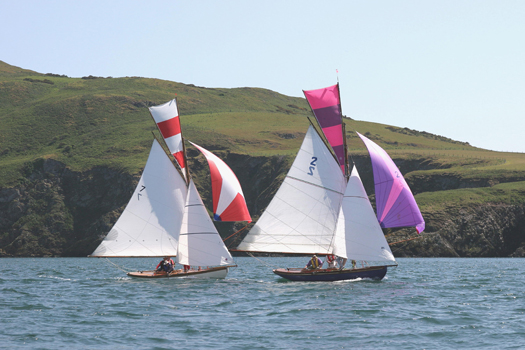
Racing round Lambay. Close competition between the Howth 17s Aura (left) and Pauline, which have been racing annually round Lambay since 1904. Photo: John Deane
Along the Fingal mainland coast, the next inlet after Rush is Loughshinny, a lovely natural harbour with a quay to further improve the bay's shelter. There's a very active little fishing fleet, while the shoreside architecture is, how shall we say, decidedly eclectic and individualistic? Go there and you'll see what I mean.
Six miles offshore, Rockabill marks the northeast limits of Fingal. It's a fine big double-rock, with a substantial lighthouse and characterful keepers' houses attached. But as it's now automated, the only time Rockabill is inhabited is for the four summer months when a bird warden or two take up residence to monitor the rocky island's most distinguished summer residents, Europe's largest breeding colony of roseate terns.
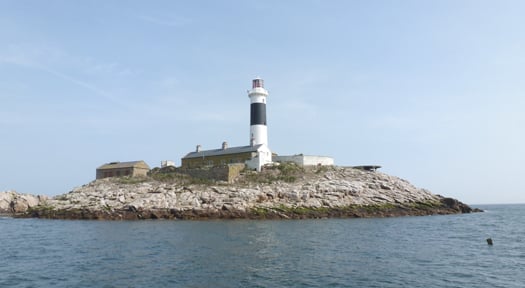
Rockabill, where the shy roseate terns feel at home. Photo: W M Nixon
In Fingal we tend to take these pretty but noisy summer visitors for granted, but the word is that south of Dublin Bay the tern buffs are so incensed by Rockabill having a clear run that they're tried to start a rival colony of roseate terns on the Muglins, and built a row of tern houses (one good tern deserves another) to facilitate their residence. The potential nest sites may not have survived the past severe winter. But in any case, one wonders if they had planning permission from Dun Laoghaire/Rathdown council for this development? Persons suggesting that such a development would almost certainly be terned down will not be given any attention whatsoever.
Skerries and Balbriggan are the two main sea towns of north Fingal, and they're as different as can be, the difference being emphasised by historic rivalry. It's said that back in the government harbour-building days of the late 19th Century a grant was made available to assist local landowners to make significant improvements to one of the harbours, and this meant war.

Balbriggan may very definitely dry out, but it provides a secure home port for both trawlers and other boats prepared to settle on the mud and sand. Photo: W M Nixon
So eventually the grant was split with half going to improve Balbriggan, and the other half to Skerries, with neither being a total success. If you seek total shelter in either today, you have to be prepared to dry out, while the anchorage off Skerries is also subject to a large tidal whorl which means that when the ebb is running in a strong onshore wind, the moorings are doubly rough and diabolically uncomfortable. And every so often after an exceptional nor'easter, we have another litany of boats driven ashore and Skerries yacht insurance going even further through the roof.
It's a situation which needs proper attention from an administration which is genuinely interested in the port. And the proper development of the harbour at Skerries, while retaining the little old place's special character, is surely something which could be much better done by Fingal Council rather than some remote Mayor of Dublin for whom Skerries will be the outermost periphery, a place seldom visited, if at all.
We've seen it all before. Time was when Fingal was simply the North County, little noticed in the centres of power which were basically Dublin City and Dublin County, their head offices in the heart of the city. But then in 2001 the new four-council setup was created, and the old name of Fingal – never forgotten by those who cherished the area – was revived. A very fine new user-friendly County Hall – it has even been praised by Frank McDonald of The Irish Times – was built in the re-born county town of Swords. Out on the new boundaries meanwhile, the signs went up saying "Welcome to Fingal County". But we old Fingallion fogeys pointed out that as Fingal means "Territory of the Fair Strangers" (i.e the Norsemen rather than the Danes), it was superfluous to be describing it as "the county of the territory", so these days it's just Fingal, and we're happy with that.
Here in Howth, we sort of slipped into acceptance of the new setup. Once upon a time, from 1917 to 1943, Howth had its own Urban District Council. It says much for the place's remoteness from the world that the HUDC was established in the midst of one global war, and quietly wound up in the midst of another. In 1943, Commissioners had to be imposed on the tiny fiefdom to offset the fact that some local interests thought the HUDC existed entirely for their own personal benefit. So at various times since, Howth was run either by Dublin County Council, or even by Dublin City Corporation. We were assured that this latter setup was all to our benefit, as the powers-that-be in City Hall had a soft spot for Howth, sure wasn't it the place where the mammy went every Thursday evening to buy the family's fish, and wouldn't she want to see it looking well?
Maybe so, but when it came to doing something more useful with the harbour, Howth Yacht Club – having re-constituted itself in 1968 from an amalgamation of Howth Sailing Club (founded 1895) and Howth Motor Yacht Club (founded 1934) - found itself dealing with a bewildering variety of government departments as the lowly interests of fishing and its ports seemed to be shifted whenever possible by civil servants who reckoned that banging the drum on behalf of fisheries in particular, and maritime interests in general, was not a shrewd career move for anyone planning a steady progress up the very landbound Irish public service ladder to the sunlit uplands of a long and prosperous retirement.
So if at times absolutely nothing seemed to be happening in a harbour which was painfully inadequate for expanding boating and fishing needs, it was partly because the club officers and fishermen's leaders could find it difficult to discern just who in authority could or would make the decisive call. In those days it turned out to be somewhere in the hidden recesses of the Office of Public Works. Suddenly, in 1979, a plan for the major re-development of the harbour was promulgated at official level, with a radical rationalisation planned for its future use. The western part, it was proposed, would become totally fisheries, while the eastern part was to be given over to recreational boating, all of it involving major civil engineering and harbour works projects.
Looking at the successful harbour today, it all seems perfectly reasonable and sensible. But back in 1979 when HYC were presented with a time-limited take-it-or-leave-it choice, the way ahead was not at all clear. Friendships were sundered and family feuds emerged from the heated progress towards accepting the offer that the club agree to vacate its premises on the West Pier - a clubhouse which it had renovated and extended only ten years earlier – and commit itself to the installation, at members' cost, of a marina in the eastern harbour with the obligation to build a completely new clubhouse there.

Today's Howth Harbour didn't happen overnight. This is how it was from 1982 until the new clubhouse was completed in 1987. Photo: W M Nixon
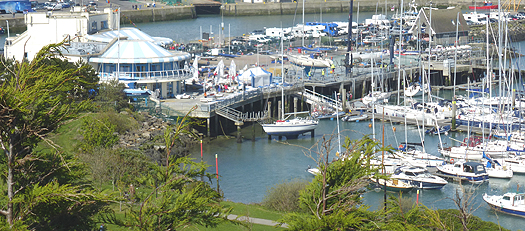
Multiple activities under way at Howth YC this week. The club's setup may seem only natural now, but it was quite a struggle to get there. Photo: W M Nixon
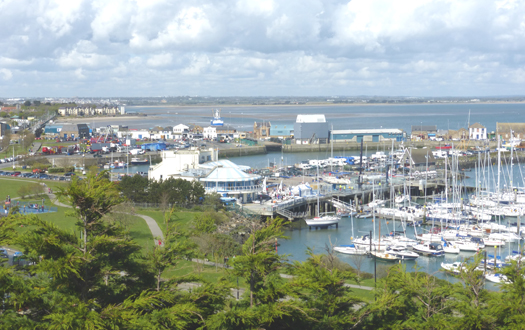
Howth's vibrant mix of a working fishing port and busy sailing centre has provided the ideal setting for the development of a successful visitor and seafood destination. Photo: W M Nixon
It's all history now, but it was done. And done so well by those involved that today it's simply taken for granted. Arguably, it's a compliment to those who created the Howth YC setup, that newer members should seldom wonder how it all came to happen, it just seems so right and natural. And as for those running the club, they in turn have to build on past achievements in dealing with an ever-changing administrative environment in which the changeover to being part of Fingal was only one of several evolutions.
Yet the recent attempt to abolish Fingal was a wake-up call. In Howth we may have wandered into it, but in just a dozen years, a dormant Fingal identity has come quietly but strongly awake. In Howth village it's natural enough, as our backs are turned to Dublin and we look to the rest of Fingal. But even on the south side of the hill, where fine houses face across Dublin Bay and you'd expect a sense of identity with households in similarly choice locations for all that they look north out of Dun Laoghaire, you find that the attraction of visiting the southside has the exotic appeal of going foreign, while those of us more humbly placed in the village, if visiting remote places like Rathmines or Terenure, find it positively unnerving to think of all the houses between us and the sea.
Then too, while Fingal Council has been establishing itself in our hearts and minds, it has been a good time for Howth Harbour. Good fences have been making good neighbours, and though marine administration in government has been kicked from pillar to post, an underlying Department of Fisheries recognition that their harbours cannot be only about fishing has led to a re-think on the use of buildings about the harbour, with Howth becoming an extraordinary nexus of good seafood restaurants, such that on a summer evening, despite the presence of a traditional fish and chip shop, the seafood aroma is of a proper fishing port in Brittany or Galicia. In fact, rents from the hospitality and sailing and marine industries in Howth have now reached such a level that fish landing fees – formerly the bedrock of the harbour economy – only contribute about 10% of the overall income.

The man from County Hall. Fingal Mayor Kieran Dennison is comfortable with his county's busy sailing activities, and the sailors are comfortable with him. He is seen here officially opening the J/24 Worlds at Howth in August 2013. Photo: W M Nixon
As for how we've been getting on with our new masters in County Hall up in Swords, the news is good. Most recently, we've been having direct contact with the current Mayor of Fingal, Kieran Dennison, who hit just the right note when he officially opened the J/24 Worlds in Howth in August 2013. Following that, he was back at the annual Commodore's Lunch in HYC in the dark days of November when a review of the past season lightens the onset of winter, and he was able to tell us that thanks to contacts made at the Worlds, his invitation to visit the America's Cup in San Francisco in September was made even more enjoyable. Those of us who reckoned the only way to visit the 34th America's Cup was on the television screen were reassured by the thought that if somebody was going to represent us in the San Francisco bear-pit, then our Mayor, our very own Mayor of Fingal, was just the man for the job.
So we very much want to keep Fingal in existence and in robust good health, but we appreciate that its current boundaries might be creating a bit of a Ukraine-versus-Russia situation. In particular, the southwest of the county could well be Fingal's Crimea and Donetsk regions. There, relatively new settlements of ethnic Dubs in places like Clonsilla, Castleknock, Blanchardstown could become such a source of trouble that it might be better to transfer them peacefully to administration by either Dublin city or South Dublin before there is unnecessary bloodshed.
The situation arises because, when the boundaries were being drawn, southwest Fingal was set out all the way down to the Liffey. The Fingallion instinct would be to see the border drawn along the Tolka, in other words the M3. But there could be trouble because of the discovery – always something of a surprise – that the Phoenix Park is in Fingal. I could see that when some people find our Fingal includes the Park, they'll want to fight for it, particularly as, in the southeast of the county, the excellent St Anne's Park in Raheny was somehow allowed to slip into Dublin City.
One thing which is definitely not for transfer is the Airport. It is naturally, utterly and totally part of Fingal. For sure, it contributes a fifth of the county's annual income from business rates, making Fingal the economically healthiest Irish county. But we in Fingal have to live with the airport very much in our midst. If Dublin really wants to take over the airport, then a first condition before negotiations even begin would be that all flight paths are to be re-routed directly over Dun Laoghaire and Dalkey. A few weeks of that would soon soften their cough.
Whatever, the recent kerfuffle about Fingal rejecting involvement in administration by an all-powerful Mayor of Dublin has been a powerful stimulant to thinking about how our own county might best be run. Everyone will have their own pet local projects, and most of us will reckon that decision-making in Swords, rather than in some vast and impenetrable office in the middle of Dublin, will be the best way to bring it about. For those of us who go afloat, the fact that Fingal Council shows that it cherishes its long and varied sea coast, rather than preferring to ignore it, is very encouraging. And the fact that this prospering county has some financial muscle all of its own gives us hope that we can build on what the past has taught us, and spread improved facilities to every port. Should that happen, it will in turn benefit Irish sailing and boating generally to a greater extent than would restricted development under one closely-controlled central administration headed by some southside megalomaniac.





























